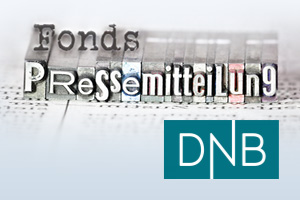
Im Februar verzeichnete der DNB High Yield A Acc EUR (WKN A2AJDN, ISIN LU1303785361) eine Rendite von -5,33 Prozent in Euro, was die bisherige Jahresperformance auf -5,90 Prozent in Euro absinken ließ. Der Sektor skandinavischer Hochzinsanleihen wurde durch die Ausbreitung des Coronavirus erheblich belastet, hinzu kam der jüngste Absturz des Ölpreises. Mit 180 Anleihen von 140 Emittenten ist das FondsPortfolio breit genug aufgestellt, um diese Situation zu meistern. DNB-FondsManager Anders Buvik gibt in seinem Monatsbericht einen aktuellen Marktüberblick und berichtet über die jüngsten Veränderungen in der Portfoliostruktur des in der Strategie SJB Substanz enthaltenen Fonds.
Until mid-February Nordic High Yield markets developed quite well. With the spreading of the coronavirus, equity markets fell 6-8 %. The general turmoil also affected high yield markets, and Nordic high yield funds typically fell 1 % during the month.
Fund performance
The fund had a negative return of around -1% in February, generally driven by the market turmoil towards the end of the month. Negative contributions were evenly distributed across the portfolio. Falling prices lead to higher yields, and it remains too been seen if increased spreads will be accompanied by higher default rate.
Outlook for the fund
High yield bonds are more exposed to price fluctuations and have higher default risk than investment grade bonds. As compensation, coupons are higher. We have a good buffer against defaults, but prices will to some extent follow the general development of the Nordics and other markets for risky assets.
But again I would like to highlight the general long term risk/reward profile of a high yield investments. The main ambition of a portfolio manager is keeping the default rates low or even better avoiding any defaults.
Looking back to 2015/2016 when oil price dropped from above 100 to 30 USD per barrel, Norway’s economy was hit hard, even harder compared to the financial crisis in 2008/2009. We are not there yet, but our main goal is to keep the default rates low by doing a consequent and detailed credit analysis. As already mentioned before, higher spreads don’t mean higher default rates. With more than 180 bonds of more than 140 issuers our fund is very well diversified.
Nordic economies
The Corona virus outbreak dominates the news flow and will probably continue to do so for some time, relegating the importance of macroeconomic news and figures. It is highly likely that both macroeconomic numbers and company reports will lose much of their relevance in the short term as they will increasingly become influenced by the effects of the virus and the measures put in place by authorities to contain the virus. But if we look at the data we have seen in February they mainly confirm the previous picture of a slightly slowing GDP growth in the Norwegian economy. Among other things, the oil companies’ estimate of investments in 2020 points to a slightly positive growth in oil investments, down from around 15% in 2019. Also, private consumption growth has remained relatively lackluster. In sum the latest developments have increased the probability of a rate cut(s) from the Norwegian central bank. In light of the virus situation the Norwegian government has also made it clear that they stand ready to effect fiscal policy initiatives if warranted.
Just as in Norway the Swedish outlook is clouded by the Corona outbreak. The official GDP growth estimate of 1.1% for 2020 from the Finance Ministry is likely to come down. Macro numbers coming in are so far more or less in line with expectations but the effects of slower global growth and also potential containment measures are still to be felt. Given that the Swedish central bank rate is quite low (the Riksbank recently hiked the rate to zero) and that the central bank has probably become more reluctant to employ negative rates, the main tool for fighting potential economic effects from COVID-19 is likely to be fiscal policy. It has been reported that there have been meetings between Swedish authorities and larger companies to look at potential support packages to counteract possible short term challenges stemming from reduced demand or disruption of supply chains.
Supplementary comments on oil price development
The Corona virus outbreak continues to dominate the oil market. In February, the oil price fell from around 56 to 50 USD/bbl. It has become continuously clearer that the near term outlook for global growth and oil demand has been seriously hit by the virus outbreak.
The SEK strengthened by around 1% while the NOK weakened by around 3% in trade weighted terms in February. For the NOK increased expectation of interest rate cuts from the central bank and the lower oil price contributed.
The oil price has fallen sharply over the weekend (7.-8.3.2020) on the news that OPEC did not manage to reach agreement on production cuts in the face of reduced demand following from the Corona virus outbreak. The combined effects of increasing measures to contain the virus and the fall in the oil price have led to massive sell-offs in the equity markets and also to considerable widening of credit spreads globally.
The effects have also been felt in the Nordic high yield market where we have seen reduced performance of our high yield fund over the last 2 weeks. From February 20 until March 6th the hedged fund fell by about 2% points, over the same period the global equity market (in local currencies) was down about 12%. The oil price fall and the marked fall in equity markets on Monday March 9th will lead to a further fall in the return of our high yield strategy. The relationship between the general sell-off in risk asset markets (equities) and the return of our high yield fund in this period is about what one should expect to see in periods of market turmoil, i.e. the return of the high yield fund will also fall but considerably less than equity markets (and in this case also less than European and US high yield, at least so far).
If we look at the effects of the oil price we think that the impact on the fund will be critically dependent on whether the lower oil price is a relatively short term phenomenon (i.e. some weeks to some months) or whether the oil market has established a new ‘equilibrium’ price. In the former case, we do not think that the oil price fall will lead to major bankruptcies and losses in the fund. The energy exposure in the fund is mainly towards the exploration and production sector and the companies we have exposure to mainly have quite low break-even prices for oil and the liquidity position for the companies are overall also quite strong. If the oil price stays at very low level for a considerable period, problems could get bigger for some of the companies. However, our main scenario is that the present situation will not last, mainly because it is suboptimal and to a certain extent irrational to keep the situation as it is for both Russia and Saudi Arabia. These two countries are among the countries hardest hit by low oil prices as both of them are heavily dependent on oil income to make public budgets viable and to pay for imports. Our base case is therefore that the presently low oil price is not a sustainable situation for the main players in this game.
As we have communicated, we still think the main risk to the fund over the next few weeks is a major sell-off in risk assets generally, leading to marked spread widening for high yield in all markets, including the Nordic market. This can clearly not be ruled out given the present situation. In this scenario we still think Nordic high yield could perform well relative to other high yield markets given the demonstrated ability and willingness from the authorities in the Nordic region to act decisively in economic policy.



